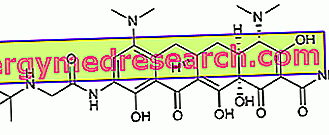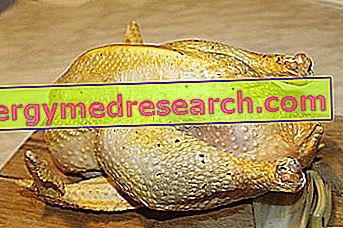Tigecycline is an antibiotic belonging to the glycylcycline group.
Glycylcycline are structurally similar molecules to tetracyclines, but which have a glycylamide within their chemical structure.
Indications
For what it uses
Tigecycline is indicated for the treatment of:
- Complicated skin and soft tissue infections;
- Complicated infections of the abdomen.
Warnings

Tigecycline - Chemical Structure
In patients with pre-existing liver problems, a dose adjustment of tigecycline may be necessary.
In the event of any type of allergic reaction, treatment with tigecycline should be discontinued and the physician should be informed immediately.
In the event of severe abdominal pain, nausea or vomiting, it is necessary to inform the doctor immediately, as these symptoms could be a sign of pancreatitis.
Treatment with tigecycline can promote the development of superinfections with resistant bacteria or fungi.
Tigecycline should not be used in children under 8 years of age.
Tigecycline can cause side effects that can affect the ability to drive or use machines, so caution should be used.
Interactions
Tigecycline may interfere with the effectiveness of oral contraceptives .
Tigecycline may also have effects on blood clotting, therefore, it is necessary to inform your doctor if you are already taking oral anticoagulants .
In any case, the doctor must still be informed if they are taking - or if they have been recently taken - drugs of any kind, including medicines without a prescription and herbal and / or homeopathic products.
Side effects
Tigecycline can cause various types of side effects, although not all patients experience them. This is due to the different sensitivity that each person has towards the drug. Therefore, it is not said that the adverse effects occur all with the same intensity in each individual.
The main side effects that may occur during tigecycline therapy are listed below.
Gastrointestinal disorders
Treatment with tigecycline may cause:
- Nausea or vomiting;
- Diarrhea;
- Dyspepsia;
- Abdominal pain;
- Acute pancreatitis.
Hepatobiliary disorders
Tigecycline therapy can cause increased levels of liver enzymes in the bloodstream, hyperbilirubinemia, liver failure and jaundice.
Blood disorders
Treatment with tigecycline can cause a decrease in the number of platelets in the bloodstream (thrombocytopenia) which can lead to the appearance of ecchymoses and an increased risk of developing abnormal bleeding or bleeding.
Skin and subcutaneous tissue disorders
Tigecycline therapy can cause skin rash and itching. Furthermore, the drug can cause the onset of Stevens-Johnson syndrome.
Nervous system disorders
Treatment with tigecycline can cause headaches and dizziness.
Side effects related to the injection site
Intravenous administration of tigecycline may result in:
- Irritations of the vein in which the drug was administered;
- Pain, swelling, inflammation and / or redness at the injection site.
Other side effects
Other side effects that may occur during treatment with tigecycline are:
- Anaphylactic reactions in sensitive subjects;
- Pneumonia;
- Loss of appetite;
- Abscesses;
- Infections;
- Sepsis;
- Decreased wound healing rate;
- Increased blood concentrations of amylase and urea nitrogen;
- Decreased blood sugar concentration.
Overdose
If you suspect that you have overdosed on tigecycline, you must tell your doctor or nurse straight away.
Action mechanism
Tigecycline is an antibiotic with a bacteriostatic action (ie it inhibits the growth of bacterial cells, but does not kill them). It exerts its antimicrobial action by interfering with the protein synthesis of bacteria.
Protein synthesis in bacterial cells takes place thanks to the action of specific cellular organelles, the ribosomes.
The ribosomes consist of ribosomal RNA and proteins associated with each other to form two subunits: the 30S subunit and the 50S subunit.
The ribosome binds and translates the messenger RNA from the cell nucleus and synthesizes the proteins for which it encodes.
Tigecycline is able to bind reversibly to the 30S ribosomal subunit, thus hindering protein synthesis.
Mode of Use - Posology
Tigecycline is available for intravenous administration as a powder that must be dissolved in a suitable solvent just before its use.
Tigecycline should be administered by a doctor or nurse through an intravenous infusion. The infusion generally has a duration that varies from 30 to 60 minutes.
The duration of the treatment is established by the doctor, but, usually, it is of 5-14 days.
In adults, the usual starting dose of tigecycline is 100 mg. Subsequently, the dose of drug administered will be reduced to 50 mg, to be administered every twelve hours.
In adolescents from 12 to 18 years of age, the dose of tigecycline usually administered is 50 mg of drug every twelve hours.
In children aged 8 to 12 years, the dose of tigecycline usually used is 1.2 mg / kg of body weight, to be administered every twelve hours. The maximum dose that can be given every twelve hours should not exceed 50 mg of the drug.
Pregnancy and breastfeeding
Tigecycline can be potentially harmful to an unborn baby. Therefore, pregnant women - before taking the antibiotic - should seek medical advice.
Since it is not known whether tigecycline is excreted in breast milk, even mothers who are breast-feeding - before taking the drug - should seek medical advice.
Contraindications
The use of tigecycline is contraindicated in the following cases:
- In patients with known hypersensitivity to tigecycline;
- In patients with known hypersensitivity to tetracyclines.



